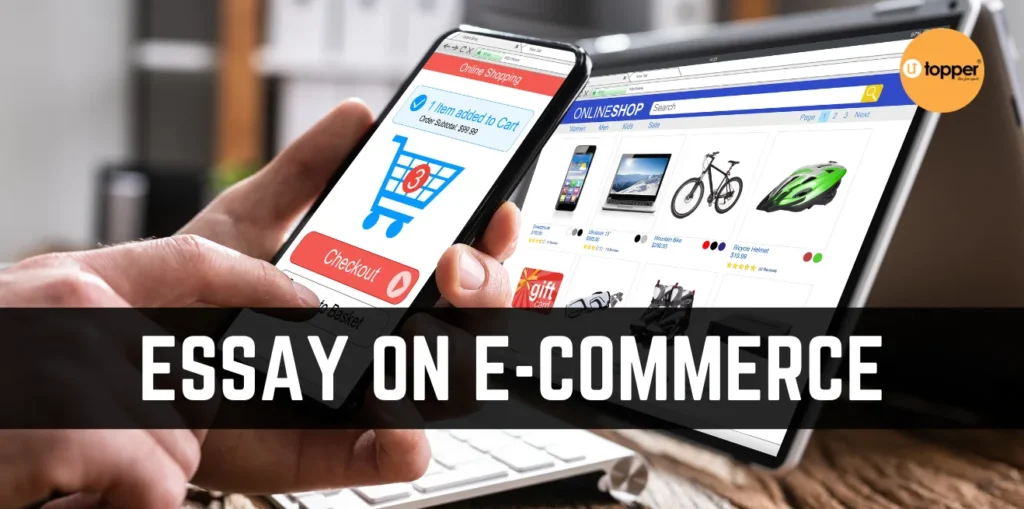
E-Commerce Essay in English
Essay on E-Commerce: E-commerce allows consumers, manufacturers, suppliers, and businesses to buy and sell goods and services online. In this Essay on E-Commerce, we will talk about the meaning, advantages, and disadvantages of E-Commerce.
You can also find more Essay Writing articles about events, people, sports, technology, and many other things.
E-Commerce, even after the “Internet revolution,” is still a relatively new, emerging, and constantly changing area of business management and information technology. E-Commerce encompasses online marketing, sales, delivery, and customer service. It transformed business. Online shopping is 24/7.
Long Essay on E-Commerce for Students
E-commerce is online buying and selling. It has transformed the business by giving companies a global audience and consumers global access to products and services. Modern business relies on e-commerce, which is growing fast.
Modern electronic commerce uses a variety of technologies, including the World Wide Web, e-mail, mobile devices, and telephones.
E-business sales involve electronic commerce. Data exchange aids business financing and payment.
Internet and electronic device sales can be classified as follows:
1. Business to Business (B2B):
This means selling to other manufacturers, trade, wholesalers, or retailers. B2B e-commerce dominates India. TELCO, IBM, C1TI BANK, BHEL, ESSAR, TVS, MARUTI, BAJAJ, and others do B2B. B2B accounted for $100 billion of 1998’s US$210 billion e-commerce.
2. Business-to-Consumer (C2B):
B2C—business-to-consumer—is our top priority. Department stores, chemists, grocery stores, books, stationery, clothes, vegetables, fruits, and more sell the products. By 2005, such sales in India are expected to grow 9000 percent to US$ 900 billion. Many service industries use this method.
3. Consumer to Consumer (C2C):
Under this system, consumers can sell old items online. However, this type of e-commerce is rare in India and generates little revenue.
4. Business to Government (B2G):
Businesses must file income, sales, and other tax returns. This requires filing a return in the appropriate office and requesting approval. E-mail/e-commerce is now legal in many countries. India has yet to do this.
5. Government to Consumer (G2C):
Email is used to sell documents, passport forms, copies of returns, and other government services to the public. E-commerce has last preference for daily consumption items because one does not physically feel or see an item and places order based on website information or consumer inquiry.
E-Commerce Benefits
For many businesses, e-commerce outweighs its drawbacks. Kurnia et al. (2015) argue that most organizations don’t understand the Internet’s capabilities. They only advertise and email customers with this resource. E-commerce implementation requires understanding its benefits. Yu, Wang, Zhong, and Huang (2016) say e-commerce must match business goals.
E-commerce helps businesses compete. Yu et al. (2016) believe most consumers will buy products in major stores. An organization must exploit other consumer buying behaviors to stay competitive.
Most customers, especially millennials and Generation X, buy online due to the Internet. Yu et al. (2016) predict that 17.5% of international retail turnover will be e-commerce by 2012. E-commerce companies can increase their customer base and stay competitive.
E-commerce allows global reach. Businesses can sell globally via the Internet. This has allowed businesses to reach customers outside their local area. E-commerce has also helped consumers find products they couldn’t find locally.
Disadvantages of E-commerce
E-biggest commerce’s drawback is the lack of product touch and feel.
Online payments are problematic. Time and legality are needed to complete the transaction. Banks and financial institutions in many countries lack a satisfactory payment system.
Many countries have legalized electronic signatures, but many more need to. Despite precautions, fraud is likely.
E-commerce requires big players to invest $100 million or Rs. 500 crore to build a brand image online. Small suppliers cannot get internet business.
The market is limited to high-income, internet-savvy people. Thus, poor, illiterate, or undereducated countries have limited access.
Sometimes a product gets flooded with orders, which delays delivery. YK2 caused delays in 2000.
Consumer issues. He must research websites, buy domains, and pay. Searching, browsing, and browsing the internet takes time and money.
Summary:
E-commerce has changed business. Businesses can reach a global audience and consumers can shop more easily. E-commerce also lets small businesses compete with big ones.
E-commerce has its drawbacks, but its benefits outweigh them, making it an essential part of modern business. E-commerce will evolve as technology advances, and it will be exciting to see how it shapes business.

